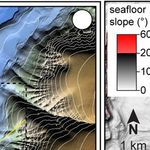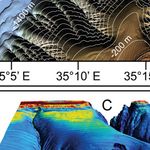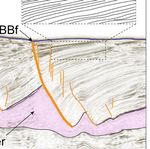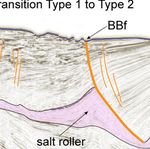Active faulting controls bedform development on a deep-water fan
←
→
Page content transcription
If your browser does not render page correctly, please read the page content below
https://doi.org/10.1130/G49206.1
Manuscript received 29 April 2021
Revised manuscript received 29 June 2021
Manuscript accepted 29 June 2021
© 2021 The Authors. Gold Open Access: This paper is published under the terms of the CC-BY license.
Active faulting controls bedform development on
a deep-water fan
Vittorio Maselli1, Aaron Micallef2,3, Alexandre Normandeau4, Davide Oppo5, David Iacopini6,
Andrew Green7 and Zhiyuan Ge8
1
epartment of Earth and Environmental Sciences, Dalhousie University, Halifax, Nova Scotia B3H 4R2, Canada
D
2
Marine Geology and Seafloor Surveying, Department of Geosciences, University of Malta, Msida 1805, Malta
3
Helmholtz Centre for Ocean Research, GEOMAR, 24148 Kiel, Germany
4
Geological Survey of Canada, Natural Resources Canada, Dartmouth, Nova Scotia B2Y 4A2, Canada
5
School of Geosciences, University of Louisiana at Lafayette, Lafayette, Louisiana 70504, USA
6
DiSTAR (Department of Earth, Environmental and Resources Sciences), Università di Napoli Federico II, 80138 Naples, Italy
7
Geological Sciences, University of KwaZulu-Natal, Durban 4041, South Africa
8
College of Geosciences, China University of Petroleum, Beijing 94305, China
ABSTRACT s upercritical and transcritical flows and thus
Tectonically controlled topography influences deep-water sedimentary systems. Using promotes the formation of antidunes and cyclic
3-D seismic reflection data from the Levant Basin, eastern Mediterranean Sea, we investi- steps (Cartigny et al., 2014). Fault topography
gate the spatial and temporal evolution of bedforms on a deep-water fan cut by an active is known to influence turbidite deposition at
normal fault. In the footwall, the fan comprises cyclic steps and antidunes along its axial the fan-scale (Ge et al., 2017, 2018), but the
and external portions, respectively, which we interpret to result from the spatial variation control of active tectonics on turbulent gravity
in flow velocity due to the loss of confinement at the canyon mouth. Conversely, in the hang- flows and associated bedforms is poorly known.
ing wall, the seafloor is nearly featureless at seismic scale. Numerical modeling of turbidity For example, it is unclear how the vertical dis-
currents shows that the fault triggers a hydraulic jump that suppresses the flow velocity placement of an active normal fault, which we
downstream, which thus explains the lack of visible bedforms basinward. This study shows term a dynamic knickpoint, influences sediment
that the topography generated by active normal faulting controls the downslope evolution deposition through supercritical and transcriti-
of turbidity currents and the associated bedforms and that seafloor geomorphology can be cal turbidity currents and how bedforms record
used to evince syn-tectonic deposition. this influence.
We integrated 3-D seismic reflection data
INTRODUCTION accumulation of plastic litter at the seafloor with numerical modeling to show how a dy-
Deep-water fans form the largest sediment (Zhong and Peng, 2021). Deep-water fans are namic knickpoint influences sediment deposi-
accumulations on Earth (Menard, 1955; Jobe dissected by a variety of erosional and deposi- tion on a deep-water fan in the Levant Basin
et al., 2018) and are archives of past tectonic and tional features, which are often interpreted as (Fig. 1; eastern Mediterranean Sea). By inves-
climatic events (Blum et al., 2018). Deep-water upper flow regime bedforms, such as antidunes tigating the interaction between active faulting
fans are primarily fed and shaped by turbidity and cyclic steps (Wynn and Stow, 2002; Fildani and sediment transport processes, we provide
currents, which are sediment-laden turbulent et al., 2006; Normandeau et al., 2019; Maier new insights into the influence of autogenic and
flows that move down subaqueous slopes un- et al., 2020). While antidunes are formed by allogenic forcing factors on turbidite deposition,
der gravity (Meiburg and Kneller, 2010) and supercritical turbidity currents (Fr > 1), cyclic which has important implications for under-
globally represent the dominant mechanism steps are related to transcritical flows, as each standing how tectonic signals are preserved in
for transporting sediment, organic matter, and step is bounded at its upstream and downstream the depositional record.
pollutants from continents to the deep sea (e.g., end by a hydraulic jump, which is a short zone
Zhong and Peng, 2021). over which the flow experiences a rapid tran- GEOLOGICAL SETTING
Turbidity currents reaching a supercritical sition from shallow and supercritical (Fr > 1) The Miocene to recent stratigraphy of the Le-
status (i.e., densimetric Froude number [Fr] to thick and subcritical (Fr < 1) (Parker and vant Basin is characterized by evaporites over-
> 1) form bedforms that are considered to be Izumi, 2000; Fildani et al., 2006; Cartigny et al., lain by up to 1.5 km of clastic deposits (Oppo
building blocks of deep-water depositional sys- 2011; Kostic, 2011). It has been proposed that et al., 2021). Tectonic forces and differential
tems (Covault et al., 2017). These bedforms are seafloor rugosity, either generated internally sediment loading led to the deformation and
thought to be responsible for the inception of (Guiastrennec-Faugas et al., 2020; Heijnen basinward movement of the evaporites (Allen
new slope channels and canyons (Fildani et al., et al., 2020) or caused by external factors (Er- et al., 2016) and generated margin-parallel, salt-
2013); they shape channel-lobe transition zones cilla et al., 2002; Covault et al., 2014; Maier detached growth faults (Fig. 2). The presence
and fans (Postma et al., 2016) and focus the et al., 2017), controls the velocity of (near) of fault escarpments at the seafloor (Figs. 1A
CITATION: Maselli, V., et al., 2021, Active faulting controls bedform development on a deep-water fan: Geology, v. 49, p. XXX–XXX, https://doi.org/10.1130/
G49206.1
Geological Society of America | GEOLOGY | Volume XX | Number XX | www.gsapubs.org 1
Downloaded from http://pubs.geoscienceworld.org/gsa/geology/article-pdf/doi/10.1130/G49206.1/5393379/g49206.pdf
by guestA B
C
D
Figure 1. (A) Bathymetry of the study area, in 100-m-spaced contours. Dashed rectangle outlines map in B; yellow lines (1–7) indicate locations
of seismic profiles in Figure 2; red line marks the bathymetric section in D. BBf—Bedform Bounding fault; C—Canyons. (B) Seafloor slope
with fault escarpments (orange) and the BBf. (C) Three-dimensional view of the seafloor with root-mean-square (RMS) amplitude attribute. (D)
Red line indicates bathymetric section a-b in A; black line shows the simplified section used in the numerical modeling.
and 1B; and side-scan sonar images of Elias DATA AND METHODS (Fig. 1). The dominant frequency within 50 ms
et al. [2007]) indicates that fault movement is We interpreted 1650 km2 of 3-D, post-stack below seafloor is ∼90 Hz, and the vertical reso-
still ongoing. Kirchhoff, time-migrated seismic reflection data lution is ∼4.5 m assuming a P-wave velocity of
2 www.gsapubs.org | Volume XX | Number XX | GEOLOGY | Geological Society of America
Downloaded from http://pubs.geoscienceworld.org/gsa/geology/article-pdf/doi/10.1130/G49206.1/5393379/g49206.pdf
by guestFigure 2. Seismic profiles (location in Fig. 1A) show faults in orange (thicker line for the Bedform Bounding fault [BBf]) and salt deposits in
pink; blue square gives a close-up view of line 3. Line drawings of the internal stratigraphy of type 1 and 2 bedforms are presented for lines 3
and 6, respectively, which are indicated by dashed rectangles; red arrows point to the truncation of reflections; black squares (a–c) mark the
locations of the close-up views used to describe seismic facies (A to C); red curves in lines 2 and 7 are extractions of the root-mean-square
(RMS) seismic amplitude along the seismic profile and are scaled from 0 to 1.
Geological Society of America | GEOLOGY | Volume XX | Number XX | www.gsapubs.org 3
Downloaded from http://pubs.geoscienceworld.org/gsa/geology/article-pdf/doi/10.1130/G49206.1/5393379/g49206.pdf
by guest1600 m/s. The bathymetry was derived by pick- name the Bedform Bounding fault (BBf), gen- bedforms at the seafloor (Fig. 2; see red arrows
ing the first reflection and is presented at a scale erates a 35-km-long and up to 18-m-high fault in line 3). Where type 2 bedforms are present
of 25 m × 25 m. Visibility, sensu Brown (2011), escarpment at the seafloor, which dips at 35° (Fig. 2, lines 5 and 6), seismic reflections are un-
extends the ability to see geological features on seaward (Figs. 1 and 2). dulating to subparallel, dip landward, and form
this surface to ∼10 m. The uncertainty in the The fan is characterized by seafloor gradi- alternating high- and low-amplitude packages,
calculation of seafloor gradients is 5%–10%. ents of ∼1.2° and ∼0.2° landward and seaward which are separated by linear to undulating ero-
We used a velocity of 1500 m/s for time to depth of the BBf, respectively. In the footwall of the sional surfaces that dip landward (Fig. 2, fa-
conversion of the seafloor surface. Since seabed BBf, two types of bedforms are visible at the cies B). Truncated reflections, which also dip
sediment sampling is lacking, we used the root- seafloor: type 1 in the axial fan section, and type landward, are visible on the lee side of type 2
mean-square (RMS) amplitude attribute of the 2 on its external portions (Fig. 1B). Type 1 bed- bedforms at the seafloor (Fig. 2; see red arrows
seafloor reflection as a proxy for sediment grain forms are crescentic in shape, 35–50 m high and in line 6). The transition from seismic facies
size, with high amplitude indicating coarser de- 830–1465 m long, and have an aspect ratio of A to B, which also corresponds to the change
posits, as suggested in other studies (Chen and ∼30. In cross section, the bedforms are asym- from type 1 to type 2 bedforms at the seafloor, is
Sidney, 1997; Maselli et al., 2019). metric and have lee and stoss side gradients of clearly visible on a section oriented perpendicu-
We also conducted a series of numerical 12.2°–23.7° and 4.1°–6.4°, respectively (Fig. 1); lar to the main slope direction (Fig. 2, line 7).
simulations of turbidity currents running on a these values decrease in an upslope direction On the hanging wall of the BBf, seismic
simplified topography derived from a bathy- (Section S3 in the Supplemental Material). The packages thin seaward and are characterized by
metric section along the fan axis (Figs. 1A and escarpment of the BBf is also partially reworked low-amplitude continuous, inclined to divergent,
1D). The model uses Reynolds-Averaged Na- by coalescent type 1 bedforms (Section S4 in reflections (Fig. 2, line 1), and alternate with
vier–Stokes (RANS) methods with k – ε Renor- the Supplemental Material). Type 2 bedforms higher amplitude reflections (Fig. 2, facies C).
malization Group (RNG) turbulence to simulate have slightly sinuous crests and are 5–30 m high Seismic facies change abruptly from A to C at
the control of the fault throw and seafloor slope and 910–1670 m long (Fig. 1), which gives an the BBf fault (Fig. 2, lines 1–6). The overall
on the hydraulic and depositional/erosional aspect ratio >50. In cross section, the bedforms wedge-shaped geometry of seismic strata indi-
processes of turbidity currents (see Section S1 are asymmetric with lee and stoss side gradients cates syn-depositional growth associated with
in the Supplemental Material1). Based on con- of 7.3°–2.6° and 3.6°–0.5°, respectively (Sec- normal fault activity.
straints from Covault et al. (2014), the flow is tion S3 in the Supplemental Material). The BBf
15 m thick with an initial velocity of 1.5 m/s marks a sharp transition from the bedform fields DISCUSSION
and sediment concentration of 0.4% (0.1% silt, to a seismically featureless seafloor in the near- Interpretation of Inferred Flow Properties
0.2% very fine sand, 0.1% fine sand). These est 4 km seaward of the BBf (Fig. 1). This region from Bedforms
values are consistent with field data from the has an overall convex-up morphology (Fig. 2; We interpret type 1 bedforms as partially
La Jolla Fan (southern California; Maier et al., Section S4 in the Supplemental Material), which depositional cyclic steps because of >10° dip-
2020), where muddy sediments are interbed- corresponds to a sediment apron (Fig. 2, line 1; ping lee and stoss sides, erosional lee sides, and
ded with well-sorted sands, and the Congo Section S5 in the Supplemental Material). Far- backstepping stratigraphy, and type 2 as antid-
Canyon (west Africa; Simmons et al., 2020), ther basinward, a new series of sediment waves unes because of gentler gradients, larger aspect
where dilute flows (fine sand develop considerably steep lee sides cally active settings and for the sequestration of relaxation) and lead to the synchronous deposi-
(Cartigny et al., 2014), which agrees with the land-derived material in the deep ocean. tion of antidunes and cyclic steps.
24° dipping lee faces we observe in type 1 bed- The reduced seafloor gradient in the hanging
forms (cyclic steps). wall (∼0.2°) could also control the transition to ACKNOWLEDGMENTS
a Froude subcritical flow and thus explain the We thank Wissam Chbat and the Lebanese
Petroleum Administration for data access and for
Influence of a Dynamic Knickpoint on lack of visible bedforms, as discussed by Zhong allowing publication of this work, and Schlumberger
Turbidity Currents et al. (2015). Recent studies from offshore Cali- for granting Petrel academic licenses. We are grate-
The disappearance of bedforms and the de- fornia based on bathymetric data with (sub)me- ful to editor Gerald Dickens, and to Andrea Fildani,
crease in seafloor gradient from ∼1.2° to ∼0.2° ter-scale resolution, however, have shown that Matthieu Cartigny, and an anonymous reviewer for
suggestions that greatly improved the manuscript. V.
across the BBf indicate that the fault has had a small-scale bedforms can be widespread over
Maselli acknowledges support from the Natural Sci-
dominant control on the behavior of turbidity the surface of deep-water fans, which suggests ences and Engineering Research Council of Canada
currents and the sedimentological properties that supercritical and transcritical flows may still Discovery Grant (RGPIN-2020–04461). A. Micallef
and geometry of the fan. Modeling results of develop in low-gradient settings for a given flow acknowledges support from the Horizon 2020 Euro-
a turbidity current show that the flow is super- depth and sediment concentration (Maier et al., pean Research Council program (677898, MARCAN).
critical over the fan and that the knickpoint 2020; Fildani et al., 2021).
formed by the BBf triggers a larger hydraulic REFERENCES CITED
Allen, H., Jackson, C.A.-L., and Fraser, A.J., 2016,
jump at its base, which reduces flow velocity CONCLUSION Gravity-driven deformation of a youthful saline
and Froude number and hampers the develop- Our study shows that deep-water fans are giant: The interplay between gliding and spreading
ment of visible bedforms seaward of the fault sculpted into supercritical and transcritical bed- in the Messinian basins of the Eastern Mediterra-
(Fig. 3). forms and that the topography generated by ac- nean: Petroleum Geoscience, v. 22, p. 340–356,
https://doi.org/10.1144/petgeo2016-034.
The formation of hydraulic jumps in turbid- tive normal faulting triggers a hydraulic jump
Blum, M., Rogers, K., Gleason, J., Najman, Y., Cruz,
ity currents due to seafloor irregularities, either that suppresses the flow velocity of turbidity cur- J., and Fox, L., 2018, Allogenic and autogenic
generated by tectonics or mass-transport depos- rents downstream and thus hampers bedform signals in the stratigraphic record of the deep-sea
its, has been investigated in different settings development and influences facies distribution. Bengal Fan: Scientific Reports, v. 8, 7379, https://
(Ercilla et al., 2002; Covault et al., 2014; Ge This outcome has two key implications: (1) the doi.org/10.1038/s41598-018-25819-5.
Brown, A.R., 2011, Interpretation of Three-Dimen-
et al., 2017; Howlett et al., 2019). Our results nature and distribution of bedform fields can be sional Seismic Data, 7th edition: Tulsa, Oklaho-
indicate that sedimentary bedforms may record used to quantify intervals of syn-tectonic de- ma, Society of Exploration Geophysicists, 646 p.
the interaction between turbidity currents and position in the stratigraphic record, which thus Cartigny, M.J.B., Postma, G., van Den Berg, J.H., and
topography generated by active faulting at the supports the interpretation of turbidite fans in Mastbergen, D.R., 2011, A comparative study of
sediment waves and cyclic steps based on geom-
seafloor (i.e., a dynamic knickpoint) and thus other active settings such as rifted margins and
etries, internal structures and numerical model-
can help to quantify intervals of syn-tectonic salt-dominated basins; and (2) sediments, and ing: Marine Geology, v. 280, p. 40–56, https://
deposition in the stratigraphic record. We show associated organic matter and anthropogenic doi.org/10.1016/j.margeo.2010.11.006.
that tectonically induced rugged topography pollutants, are vigorously transported into the Cartigny, M.J.B., Ventra, D., Postma, G., and van
may suppress supercritical to transcritical flows deepest reaches of the oceans. Our results also Den Berg, J.H., 2014, Morphodynamics and sed-
imentary structures of bedforms under supercrit-
and thus influence the distribution of sedimen- indicate that the loss of confinement at the can- ical-flow conditions: New insights from flume
tary facies within the fan, which has important yon mouth can generate spatial variation in the experiments: Sedimentology, v. 61, p. 712–748,
implications for reservoir properties in tectoni- flow velocity of the turbidity currents (i.e., flow https://doi.org/10.1111/sed.12076.
A Figure 3. Modeling results
for (A) velocity magnitude,
(B) sediment concen-
tration, and (C) Froude
number (Fr) of a turbid-
ity current flowing over
a simplified topography.
Note that the flow expe-
riences a hydraulic jump
across the fault scarp, and
B Fr isChen, Q., and Sidney, S., 1997, Seismic attribute tech- knickpoints and related sedimentary processes of deep-water sediment waves offshore eastern
nology for reservoir forecasting and monitoring: in a submarine canyon from a rare 20-year mor- Canada: Sedimentology, v. 66, p. 1746–1767,
The Leading Edge, v. 16, p. 445–448, https://doi phobathymetric time-lapse (Capbreton submarine https://doi.org/10.1111/sed.12557.
.org/10.1190/1.1437657. canyon, Bay of Biscay, France): Marine Geol- Oppo, D., Evans, S., Iacopini, D., Kabir, S.M.M.,
Covault, J.A., Kostic, S., Paull, C.K., Ryan, H.F., and ogy, v. 423, 106143, https://doi.org/10.1016/ Maselli, V., and Jackson, C.A.-L., 2021, Leaky
Fildani, A., 2014, Submarine channel initiation, j.margeo.2020.106143. salt: Pipe trails record the history of cross-evap-
filling and maintenance from sea-floor geomor- Heijnen, M.S., et al., 2020, Rapidly-migrating and orite fluid escape in the northern Levant Ba-
phology and morphodynamic modelling of cy- internally-generated knickpoints can control sin, Eastern Mediterranean: Basin Research,
clic steps: Sedimentology, v. 61, p. 1031–1054, submarine channel evolution: Nature Commu- v. 33, p. 1798–1819, https://doi.org/10.1111/
https://doi.org/10.1111/sed.12084. nications, v. 11, https://doi.org/10.1038/s41467- bre.12536.
Covault, J.A., Kostic, S., Paull, C.K., and Sylvester, 020-16861-x. Parker, G., and Izumi, N., 2000, Purely erosional
Z., 2017, Cyclic steps and related supercritical Howlett, D.M., Ge, Z., Nemec, W., Gawthorpe, R.L., cyclic and solitary steps created by flow over
bedforms: Building blocks of deep-water depo- Rotevan, A., and Jackson, C.A.-L., 2019, Re- a cohesive bed: Journal of Fluid Mechanics,
sitional systems, western North America: Marine sponse of unconfined turbidity current to deep- v. 419, p. 203–238, https://doi.org/10.1017/
Geology, v. 393, p. 4–20, https://doi.org/10.1016/ water fold and thrust belt topography: Orthogo- S0022112000001403.
j.margeo.2016.12.009. nal incidence on solitary and segmented folds: Pohl, F., Eggenhuisen, J.T., Tilston, M., and Cartigny,
Elias, A., Tapponnier, P., Singh, S.C., King, G.C.P., Sedimentology, v. 66, p. 2425–2454, https://doi M.J.B., 2019, New flow relaxation mechanism
Briais, A., Daëron, M., Carton, H., Sursock, A., .org/10.1111/sed.12602. explains scour fields at the end of submarine
Jacques, E., Jormaa, R., and Klinger, Y., 2007, Jobe, Z.R., Howes, N., Romans, B.W., and Covault, channels: Nature Communications, v. 10, https://
Active thrusting offshore Mount Lebanon: Source J.A., 2018, Volume and recurrence of submarine- doi.org/10.1038/s41467-019-12389-x.
of the tsunamogenic A.D. 551 Beirut-Tripoli fan-building turbidity currents: The Depositional Postma, G., Hoyal, D.C., Abreu, V., Cartigny, M.J.B.,
earthquake: Geology, v. 35, p. 755–758, https:// Record, v. 4, p. 160–176, https://doi.org/10.1002/ Demko, T., Fedele, J.J., Kleverlaan, K., and Ped-
doi.org/10.1130/G23631A.1. dep2.42. erson, K.H., 2016, Morphodynamics of super-
Ercilla, E., Wynn, R.B., Alonso, B., and Baraza, J., Kostic, S., 2011, Modeling of submarine cyclic steps: critical turbidity currents in the channel-lobe
2002, Initiation and evolution of turbidity current Controls on their formation, migration, and ar- transition zone, in Lamarche, G., et al., eds.,
sediment waves in the Magdalena turbidite sys- chitecture: Geosphere, v. 7, p. 294–304, https:// Submarine Mass Movements and Their Conse-
tem: Marine Geology, v. 192, p. 153–169, https:// doi.org/10.1130/GES00601.1. quences: Dordrecht, Netherlands, Springer Sci-
doi.org/10.1016/S0025-3227(02)00553-4. Maier, K.L., Brothers, D.S., Paull, C.K., McGann, M., ence, Advances in Natural and Technological
Fildani, A., Normark, W.R., Kostic, S., and Parker, Caress, D.W., and Conrad, J.E., 2017, Records Hazards Series, v. 41, p. 469–478.
G., 2006, Channel formation by flow stripping: of continental slope sediment flow morphody- Simmons, S.M., Azpiroz-Zabala, M., Cartigny, M.J
Large-scale scour features along the Monterey namic responses to gradient and active faulting B., Clare, M.A., Cooper, C., Parsons, D.R., Pope,
East Channel and their relation to sediment waves: from integrated AUV and ROV data, offshore E.L., Sumner, E.J., and Talling, P.J., 2020, Nov-
Sedimentology, v. 53, p. 1265–1287, https://doi Palos Verdes, southern California Borderland: el acoustic method provides first detailed mea-
.org/10.1111/j.1365-3091.2006.00812.x. Marine Geology, v. 393, p. 47–66, https://doi surements of sediment concentration structure
Fildani, A., Hubbard, S.M., Covault, J.A., Maier, K.L., .org/10.1016/j.margeo.2016.10.001. within submarine turbidity currents: Journal of
Romans, B.W., Traer, M., and Rowland, J.C., Maier, K.L., Paull, C.K., Caress, D.W., Anderson, Geophysical Research: Oceans, v. 125, https://
2013, Erosion at inception of deep-sea channels: K., Nieminski, N.M., Lundsten, E., Erwin, B.E., doi.org/10.1029/2019JC015904.
Marine and Petroleum Geology, v. 41, p. 48–61, Gwiazda, R., and Fildani, A., 2020, Submarine- Slootman, A., and Cartigny, M.J.B., 2020, Cyclic
https://doi.org/10.1016/j.marpetgeo.2012.03.006. fan development revealed by integrated high- steps: Review and aggradation-based classifica-
Fildani, A., Kostic, S., Covault, J.A., Maier, K.L., Ca- resolution datasets from La Jolla fan, offshore tion: Earth-Science Reviews, v. 201, https://doi
ress, D.W., and Paull, C.K., 2021, Exploring a California, U.S.A: Journal of Sedimentary Re- .org/10.1016/j.earscirev.2019.102949.
new breadth of cyclic steps on distal submarine search, v. 90, p. 468–479, https://doi.org/10.2110/ Wynn, R.B., and Stow, D.A.V., 2002, Classification
fans: Sedimentology, v. 68, p. 1378–1399, https:// jsr.2020.22. and characterisation of deep-water sediment
doi.org/10.1111/sed.12803. Maselli, V., Kneller, B., Taiwo, O.L., and Iacopini, waves: Marine Geology, v. 192, p. 7–22, https://
Ge, Z., Nemec, W., Gawthorpe, R.L., and Hansen, D., 2019, Sea floor bedforms and their influence doi.org/10.1016/S0025-3227(02)00547-9.
E.W.M., 2017, Response of unconfined turbidity on slope accommodation: Marine and Petro- Zhong, G., Cartigny, M.J.B., Kuang, Z., and Wang,
current to normal-fault topography: Sedimentol- leum Geology, v. 102, p. 625–637, https://doi L., 2015, Cyclic steps along the South Taiwan
ogy, v. 64, p. 932–959, https://doi.org/10.1111/ .org/10.1016/j.marpetgeo.2019.01.021. Shoal and West Penghu submarine canyons on
sed.12333. Meiburg, E., and Kneller, B., 2010, Turbidity cur- the northeastern continental slope of the South
Ge, Z., Nemec, W., Gawthorpe, R.L., Rotevatn, A., rents and their deposits: Annual Review of China Sea: Geological Society of America Bul-
and Hansen, E.W.M., 2018, Response of uncon- Fluid Mechanics, v. 42, p. 135–156, https://doi letin, v. 127, p. 804–824, https://doi.org/10.1130/
fined turbidity current to relay-ramp topography: .org/10.1146/annurev-fluid-121108-145618. B31003.1.
Insights from process-based numerical model- Menard, H.W., 1955, Deep-sea channels, topography, Zhong, G., and Peng, X., 2021, Transport and accumu-
ling: Basin Research, v. 30, p. 321–343, https:// and sedimentation: American Association of Pe- lation of plastic litter in submarine canyons—The
doi.org/10.1111/bre.12255. troleum Geologists Bulletin, v. 39, p. 236–255. role of gravity flows: Geology, v. 49, p. 581–586,
Guiastrennec-Faugas, L., Gillet, H., Jacinto, R.S., Den- Normandeau, A., Campbell, D.C., and Cartigny, https://doi.org/10.1130/G48536.1.
nielou, B., Hanquiez, V., Schmidt, S., Simplet, M.J.B., 2019, The influence of turbidity cur-
L., and Rousset, A., 2020, Upstream migrating rents and contour currents on the distribution Printed in USA
6 www.gsapubs.org | Volume XX | Number XX | GEOLOGY | Geological Society of America
Downloaded from http://pubs.geoscienceworld.org/gsa/geology/article-pdf/doi/10.1130/G49206.1/5393379/g49206.pdf
by guestYou can also read



























































